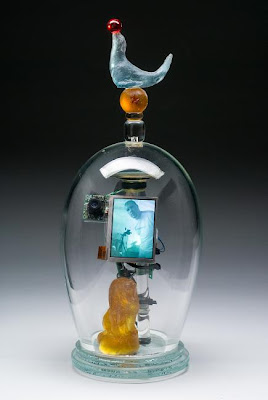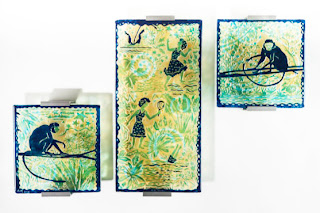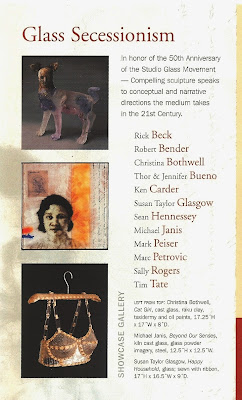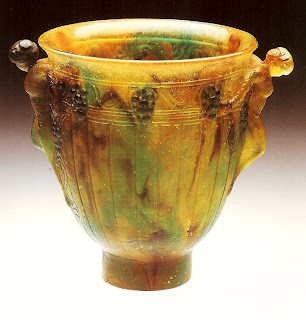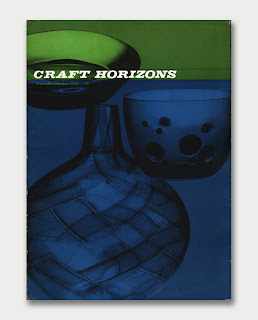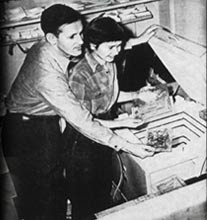As the arrangements for the UK artists are being finalized, the Washington Glass School blog takes a look back to the first two collaborative exhibitions and their outcome.
GLASS 3__________________________
In 2008, Artomatic organized an exhibit that showcased glass art, focusing on how three “glass” cities approach the medium. The collaborative show was titled “Glass 3” referencing the invited glass centers of Washington, DC, Toledo, Ohio and Sunderland, England.
- Sunderland is home to the UK’s National Glass Centre at the University of Sunderland. The North East of England has a long tradition of glassmaking – since the 7th century as glassmakers from France were brought in to make the stained glass windows. The numerous glass factories of the 17th and 18th century have now closed, and in its place a number of studio glass artists working in smaller studios.
- Toledo, Ohio is known as “Glass City” – where in 1962, Harvey Littleton and Dominick Labino presented the seminal glass workshop with the Toledo Museum of Art. This workshop profoundly influenced the American Studio Glass Movement.
- Washington, DC glass artists work at using glass as an expressive component in a larger whole, mastering technique in order to express content. The “post-craft” artists strive to make works that transcend words and discrete disciplines – therein lies their beauty.
 |
| Design of the Glass 3 exhibit graphics and catalog by Jon Gann. |
Artomatic had secured an exhibition space in the Georgetown Mall, and in February, artwork and artists from the UK and Ohio came into DC setting up the multi-level space.
 |
| 2008 “Glass 3” Exhibit. Photo by Tracy Lee. |
 |
| 2008 “Glass 3” Exhibit. Photo by Tracy Lee. |
 |
||||
| Artist Vanessa Cutler (R) talks about the UK artwork with Sunderland City Council’s Anne Tye (C) and DCist’s Heather Goss (L) on opening night. |
DCist city blog writer Heather Goss wrote of the 2008 collaborative show “Glass 3”:
“But does all of this lovey-dovey, hands-around-the-world stuff translate into a good art show? In this case, definitely. Glass work has always faced a tough challenge being accepted as “fine art” and not “a bunch of bowls and vases you find at the craft fair.” And if anyone can make you change your mind, its the artists from Sunderland. Some of the artists are actually experts in glass theory with Ph.Ds and have developed techniques that not only create beautiful art, but have revolutionized architecture and other uses for the medium.”
Click HERE to jump to full DCist article.
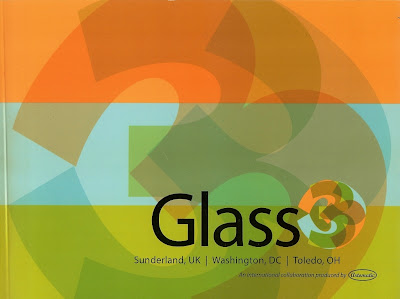 |
| A catalog of the works in the show was published, a copy is in the Corning Museum of Glass’ Rakow Library. |
Click HERE to jump to the Glass 3 catalog pdf.
The Brits returned charged up with the success of the interaction with the Americans, and based on the Washington Glass School model, created a not-for-profit artist run studio facility in Sunderland; Creative Cohesion. The new organization is home to professional artists working in glass, ceramics, fine art and mixed media, with a gallery, arts workshops and a glass hot-shop.
 |
| UK’s Stephen Reveley’s fused glass forms at 2009 Artomatic. |
Artomatic 2009__________________________
In 2009, Artomatic held the 10th anniversary of its unjuried art fair in DC’s Southeast, near the Navy Yard. 38 artists from the UK were able to participate in the event via Creative Cohesion joining with Artomatic in the planning of the exchange. A number of the visiting artists were part of the University of Sunderland and the UK’s National Glass Centre and held workshops where they demonstrated their techniques.
 |
| UK glass casting workshop by Stephen Beardsell held at Washington Glass School, May 2009. |
 |
| Sarah Blood’s neon artwork at Artomatic. |
The Artomatic was a great success, and the visiting artists were able to connect to the US artscene. Glass artist Phil Vickery’s artwork was selected by the James Renwick Alliance to receive their Craft Award of Distinction.
 |
| Award winning glass by Phil Vickery. |
 |
| 2009 UK / US Artomatic artist reception |
The connection between the sister city artists had been strengthened, andProfessor Peter Fidler, Vice Chancellor and Chief Executive of the University of Sunderland was impressed with the artists at Washington Glass School, and sought out ways to continue the interaction.
Later, after Tim Tate and Michael Janis were successful Fulbright Scholar candidates, the connection to the University of Sunderland continued; in 2012, they both were Fulbright Scholars at the University and held workshops at Creative Cohesion.
The Brits are back this year, and the exhibit has broadened to include ceramic artwork.To complement the artwork, International Glass and Clay 2013 will host panels at Pepco Edison Place Gallery all month long meant to inspire in depth conversation about cultural diplomacy, Fulbright exchanges and international artists residencies and the arts. The events will include representatives from cultural institutions in the nation’s capital, including embassies, government entities, think tanks and local arts organizations.
“This year, the DC Commission on the Arts and Humanities launched a program encouraging District artists and arts organizations to develop cultural partnerships with our sister cities, which we are proud to implement,” said Lionell Thomas, Executive Director of the DC Commission on the Arts and Humanities. “International Glass and Clay 2013 is an excellent example of how cities with differing cultures can approach diplomacy through their respective creative heritage.”
International Glass and Clay2013 will open from Friday, March 1 to Friday, March 22. It is free for the public to attend. At Pepco Edison Place Gallery, 702 Eighth Street (between G and H Street). Gallery hours are 12 to 4 p.m. on Saturdays and Tuesdays, and 12 to 8 p.m. on Wednesdays, Thursdays and Fridays. The gallery is closed on Sundays and Mondays. The Gallery Place Metro station servicing the green, red and yellow lines is within close walking distance to the gallery.

